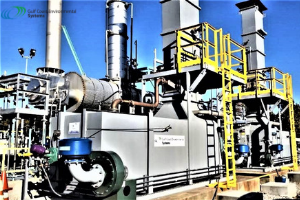Improving CI Scores Through Pollution Control: GCE Systems
Carbon neutral, carbon negative, green, sustainable operation. We have all heard the terms businesses and brands are using to show their environmental efforts and initiatives. Corporate social responsibility has become a large focus in the fight against climate change, with many industries facing immense pressure to establish green policies and implement new technologies to reduce their carbon footprint.
As organizations start or continue to “green” their supply and operations, different metrics must be examined in order to determine progress. One of the key performance indicators (KPI) that organizations are focusing on to determine their environmental effect is Carbon Intensity Scores. A Carbon Intensity Score, or CI Score, is a measurement of all total hydrocarbons, or greenhouse gas emitted, versus the amount of energy consumed.
The exact units depend on the area of focus, but carbon intensity is generally measured as grams of carbon dioxide equivalent per megajoule of energy or fuel produced (gCO2e/MJ). It is a way of quantifying the lifecycle greenhouse emissions of a product or process. Because of this, the movement to redefine “waste” has accelerated, and materials that were previously discounted or disregarded are now viewed as a valuable resource, waiting for the right application.
There are several ways an organization can improve its CI score. One of the easiest and most cost-efficient ways to do this is through the use of pollution control equipment. These specially designed systems are essential in destroying dangerous pollutants and volatile organic compounds (VOCs) that are directly linked to climate change.
In addition to emissions abatement, pollution control equipment offers a multitude of heat and waste recovery options that offset carbon emissions and generate revenue. There will be inherent emissions associated with any process, but how a facility offsets those emissions and fuel consumption matters.
Some of the ways pollution control equipment can help improve CI Scores include:
 Waste Heat Recovery: An oxidizer is a type of thermal abatement equipment that uses extremely high temperatures as a means of destruction. Heat recovery in oxidizers, like a Thermal Recuperative Oxidizer (TRO), can be accomplished in two different ways – Extracting heat from the stack or extracting heat directly from the combustion chamber. Dryer exhaust air temperature, solvent concentration, and heat exchanger efficiency determine the oxidizer stack air temperature. Destruction rate efficiency (DRE) requirements determine the combustion chamber temperature; when concentrations rise above the minimum energy required for self-sustaining operation, excess heat is generated in the combustion chamber. This excess heat is then recovered and can be used as power, reducing the demand for outside fuel sources.
Waste Heat Recovery: An oxidizer is a type of thermal abatement equipment that uses extremely high temperatures as a means of destruction. Heat recovery in oxidizers, like a Thermal Recuperative Oxidizer (TRO), can be accomplished in two different ways – Extracting heat from the stack or extracting heat directly from the combustion chamber. Dryer exhaust air temperature, solvent concentration, and heat exchanger efficiency determine the oxidizer stack air temperature. Destruction rate efficiency (DRE) requirements determine the combustion chamber temperature; when concentrations rise above the minimum energy required for self-sustaining operation, excess heat is generated in the combustion chamber. This excess heat is then recovered and can be used as power, reducing the demand for outside fuel sources.
Gas Purification – CO2 & Hydrogen: Gas cleaning, or gas purification, is the process in which emissions from industrial applications are processed, the unwanted contaminants in the stream are removed, and a mixture of target gases such as Methane, Carbon Dioxide, and/or Hydrogen remain. These remaining products are then separated and purified, which prepares them to be sold or traded. This process creates an additional stream of revenue while offsetting emissions restrictions.
Renewable Natural Gas (RNG): The RNG created by manufacturing and waste treatment emissions is incredibly valuable because it can be used interchangeably with natural gas for heat, electricity, and even transportation. Regions across the globe are starting to realize the monetary and environmental value of natural gas. In the United States, new state and federal programs and tax credits have popped up, proving a growing interest in RNG projects. Most states have programs that incentivize utility providers to purchase and use RNG in place of traditional natural gas, leading to a rather substantial demand. The new administration in the US has spoken extensively about the necessity of renewable fuel options and has already introduced legislation to encourage these types of projects. The collection and repurposing of carbon as RNG reduces greenhouse gas emissions while generating revenue.
CI scores are starting to gain a lot of attention, with some states using them as metrics to determine if a facility is within regulatory compliance. California, for instance, considers the CI score as a component of the Low Carbon Fuel Standard (LCFS) program. The LCFS is part of a group of programs that aim to reduce greenhouse gas emissions in the state. It intends to reduce carbon emissions over time, by regulating emissions, fuel usage, and encouraging renewable options. Several other states across the US are considering adopting similar programs. As we have seen in California, these regulations are quickly making an impact on traditional industry, requiring more abatement options, with higher destruction rates, and GHG-reducing options.
Gulf Coast Environmental Systems has been at the forefront of alternative energy development using pollution control equipment for nearly 2-decades. Our team of environmental experts has experience handling even the most challenging of applications, making every effort to take advantage of carbon offsetting opportunities.
To know more, please check GCE Systems.

